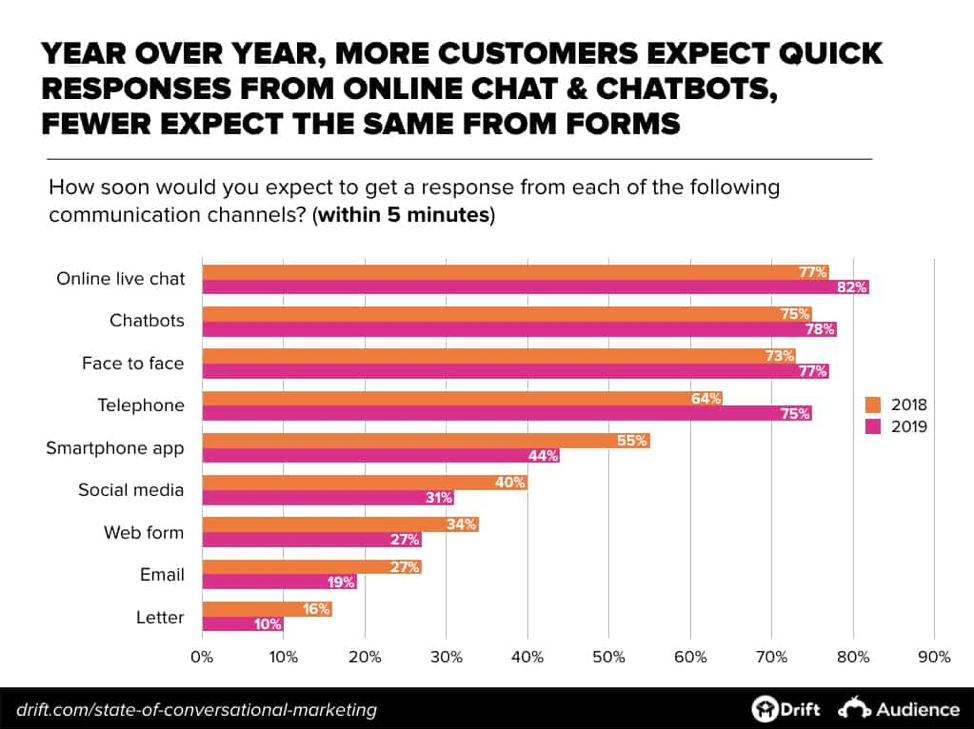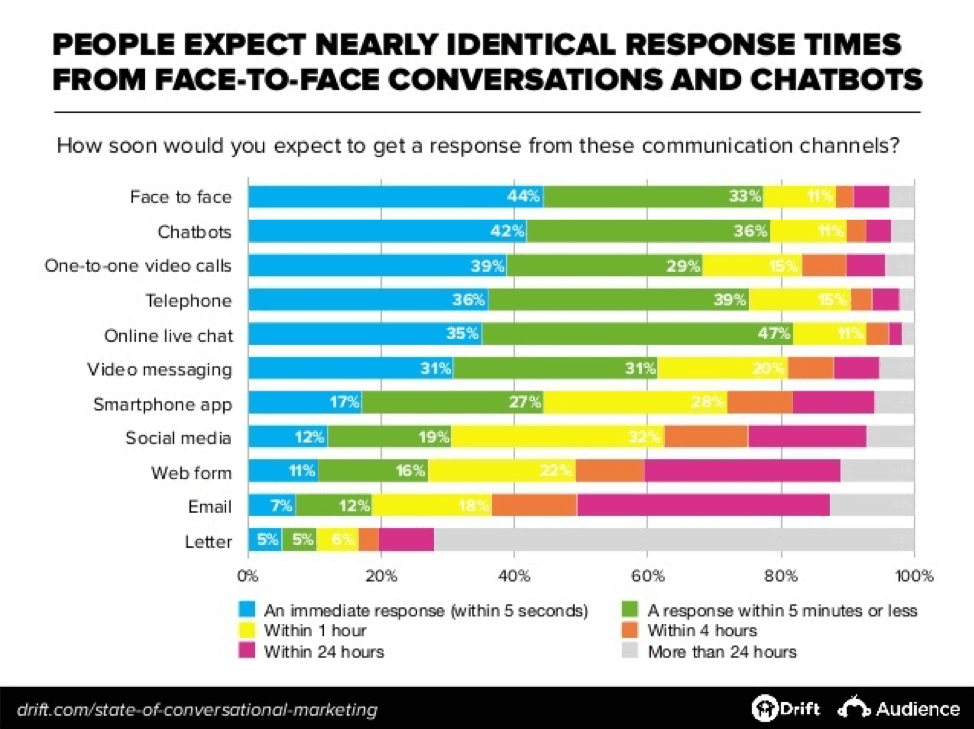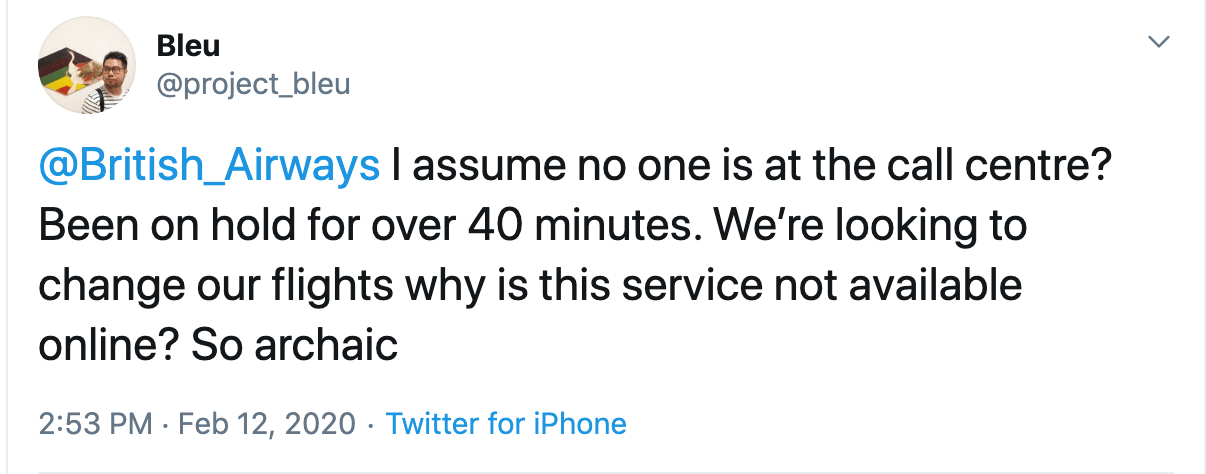
How Long Is Too Long On Hold?
Americans waste a collective 900 million hours waiting on hold every year. And, the average person will spend 43 days on hold over the course of their life.
You take a month and a half sabbatical in the time you’re waiting on hold in your lifetime. Or, you could race the Tour De France (twice!).
Hold times plague contact centers (and your customers’ lives).
And customers continue to grow increasingly impatient. So, how long is too long on hold? And, why does hold time matter to customer experience?
How long will your customers wait on hold?
According to data culled from customer surveys, two-thirds of people said they’re only willing to wait on hold for two minutes or less. And 13% said that there’s no amount of time they’d be okay with waiting on hold.
What’s more, new digital channels in the contact center drive customers to want responses even faster.
The 2019 State of Conversational Marketing Report showed how many people think responses to customer service outreach should be instant – as in five minutes or less. (Hint: A lot. And across many channels).

What’s the only channel fit for a response that takes more than 24 hours?
You guessed it: snail mail.
After all, there’s a reason traditional mail has its nickname.

How to measure hold time and why it matters.
Most companies mark hold time as a key metric. But how do you actually measure it and what do you do with the info you find? Plus, how do you make sure you view hold times through the lens of your entire customer experience, measuring its impact on other metrics, too?
According to Techopedia, average hold time is the average time it takes for an operator to answer a call. It’s the amount of time a customer waits in the queue before getting a response from an agent. Some organizations call it average speed of answer.
Several factors determine the ASA for a particular call center. But as a general rule, the time a customer spends navigating an IVR isn’t included in the ASA calculation. The metric only measures from the second your system dumps a customer into a queue to the moment an agent picks up the phone, answers a chat, or sends a reply email. (Or, until a caller hangs up – hello, spike in call abandonment rate).
How to calculate your company’s ASA:
Add up the wait time of all inbound customer calls. Then, divide the sum by the number of total inbound customer calls that were either answered by agents or resolved with the help of automation.

Once you have your benchmark hold time, compare it to the two-minute standard set by customers. Are you beating that two-minute mark or falling short? And, how does your hold time stack up this month to last? Analyze your data from multiple viewpoints to gain deeper insight into your CX.
What happens in your customer experience when customers wait on hold for too long:
1. Customers spread negativity about your company.
Putting customers on hold creates a community of brand detractors. They’re the people who are not only unhappy with your company but who share negative experiences with friends and family. And a lot of the time, they even blast negative experiences on social media. In fact, there’s an entire website, called onholdwith.com, dedicated to scanning Twitter for people who’ve tweeted about being on hold with a company.
After scanning for a slew of angry customer tweets, the website aggregates all the negative tweets into one easy-to-view dashboard. And, it refreshes in real-time, so you can see a constant influx of upset customers shouting at company Twitter handles when they’ve been on hold for 10 minutes or more.



The list goes on.
Leaving your customers hanging without a response opens your company up to the potential for public scrutiny. Take a quick peek, and you’ll immediately see dozens of companies bashed for stealing time from their customers. Yikes.
2. Customers abandon calls.
I popped my spaghetti in the microwave for 120 seconds, and now I wait. Before the “I’m finished” beep rings, agents have to answer all the interactions in their queue.
Ready… go.
If they don’t, you run the risk of a serious spike in abandonment rates. Since two-thirds of customers are only willing to wait on hold for two minutes, keeping customers on hold any longer puts other metrics at risk. And, Voice Response, Inc. said 34% of people who hang up before reaching an agent will never call back.
Read Next: Simplify omnichannel interaction routing with Sharpen’s Logic & Actions.
That means the next time the same customer has an issue, one of two situations will play out. One, the customer will quietly sneak away to a competitor who promises stellar service. Or, two, they’ll remain a customer, but they’ll silently stew in frustration with no resolution. (Only to eventually boil over and skip out to your competition anyway.)
When one important metric slips, it’s easy to topple others. As you measure hold time, view it side-by-side with quality metrics like satisfaction and loyalty, too.
How to reduce hold times to keep customers happy:
With the help of technology and improved coaching techniques, you can keep hold times down and customers happy. Here’s how.
1. Improve interaction routing and integrate all your channels.
Gone are the days of only routing phone interactions to the right agents. Customers expect answers on any (and every) channel. To make sure you’re not losing track of customer requests and spiking your hold times, use omnichannel routing. Simplify your interaction flows and get customers to the right queues. And, connect all your channels so agents work from a single interface to manage interactions more efficiently.
2. Train your agents to reduce handle times and ASA.
Give your agents the tools and training they need to handle calls autonomously. When efficiency metrics are high, review a handful of interactions and give your agents feedback in-line to coach them to improve. Did they spend forever searching for a file on one call and leave other customers hanging in a queue? Guide them to the resources they need and offer encouragement rather than reprimand.
Learn More: Simplify the agent experience so they can better serve customers
3. Make sure your contact center solutions prioritize your agents.
Clunky tools that don’t integrate with your CRM or ticketing system prolong resolutions for customers. When your agents have to jump between windows and databases, their efficiency tanks. And when agents know they’re missing metrics and under pressure, they can’t be effective, either. Build systems that put agents first, so they can better help customers.
4. Invest in true omnichannel tools for your contact center.
Omnichannel tools package your routing, data, training, and channels into a single interface. Real omnichannel means your agents can switch between interactions and channels seamlessly, without interrupting or ending customer convos. Investing in omnichannel tools cuts down on work for your agents and wait time for your customers, leading to faster (and better) resolutions.
We originally published this post on March 2, 2016 and we updated it on February 13, 2020.


